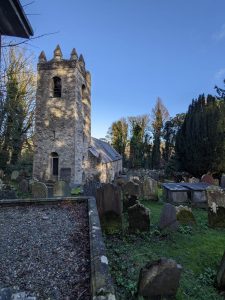 Old Kirk Braddan Church and Cemetery
Old Kirk Braddan Church and Cemetery
(Or how I can find a Napoleonic connection literally ANYWHERE)
I’ve mentioned before on this blog that I have something of a passion for old churches. One of my favourites is Kirk Braddan; not the newer Victorian building which houses the current congregation although that is very attractive. Inevitably though, I’m drawn to the older church next door. It’s no longer used regularly but services are still held there occasionally. For me, it has the atmosphere of the period I love most. It also has one or two interesting Napoleonic tombs.
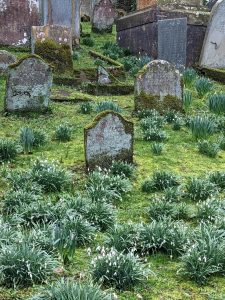 I found myself at Old Kirk Braddan earlier this week when I had an hour to kill before meeting my editor and it wasn’t worth going home first. I went initially to explore the ancient churchyard, which I love, especially at this time of year when the snowdrops and crocuses are just coming into bloom. Once there, I couldn’t resist popping into the church. It’s quiet and very lovely, with the slightly musty smell that I associate with old buildings that are seldom used.
I found myself at Old Kirk Braddan earlier this week when I had an hour to kill before meeting my editor and it wasn’t worth going home first. I went initially to explore the ancient churchyard, which I love, especially at this time of year when the snowdrops and crocuses are just coming into bloom. Once there, I couldn’t resist popping into the church. It’s quiet and very lovely, with the slightly musty smell that I associate with old buildings that are seldom used.
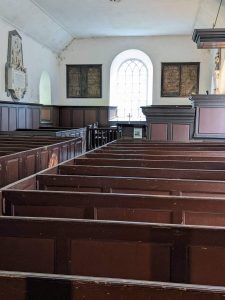 There has been some form of religious worship on this site for fourteen centuries and stones from the first Celtic Keeill (Chapel) can be dated back to around 400 AD. Old Kirk Braddan was rebuilt on the site of an older church in 1777 and is dedicated to Saint Brendan or Braddan. Unlike many other eighteenth century churches, it was never updated during the Victorian era and retains its original box pews, gallery and a three decker pulpit, with a lectern, minister’s pew and pulpit above. It remained the parish church until 1876 when it was replaced by the new church.
There has been some form of religious worship on this site for fourteen centuries and stones from the first Celtic Keeill (Chapel) can be dated back to around 400 AD. Old Kirk Braddan was rebuilt on the site of an older church in 1777 and is dedicated to Saint Brendan or Braddan. Unlike many other eighteenth century churches, it was never updated during the Victorian era and retains its original box pews, gallery and a three decker pulpit, with a lectern, minister’s pew and pulpit above. It remained the parish church until 1876 when it was replaced by the new church.
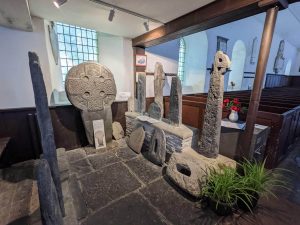 The church contains a number of Celtic and Norse crosses from the period 800-1265, which were found around the parish. Several of these bear a ring chain design which is associated with the sculptor, Gaut, son of Bjorn, who came from the island of Coll in the Hebrides and settled on the Isle of Man. Gaut is considered one of the best carvers of his time which was between 950 and 1040 AD. One of the crosses bearing his designs has been translated as “Gaut created this and all in Mann”. His carvings are of a style seen in many Celtic and later Scandinavian crosses.
The church contains a number of Celtic and Norse crosses from the period 800-1265, which were found around the parish. Several of these bear a ring chain design which is associated with the sculptor, Gaut, son of Bjorn, who came from the island of Coll in the Hebrides and settled on the Isle of Man. Gaut is considered one of the best carvers of his time which was between 950 and 1040 AD. One of the crosses bearing his designs has been translated as “Gaut created this and all in Mann”. His carvings are of a style seen in many Celtic and later Scandinavian crosses.
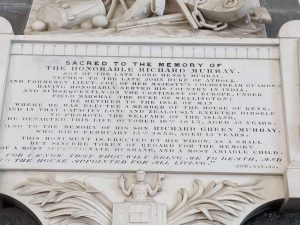 Beyond the Manx crosses, towards the altar, there’s an impressive memorial up on the wall, looking surprisingly elaborate for such a simple church.
Beyond the Manx crosses, towards the altar, there’s an impressive memorial up on the wall, looking surprisingly elaborate for such a simple church.
Sacred to the memory of the Honourable Richard Murray
Son of the late Lord Henry Murray
Nephew to the late John Duke of Atholl
and formerly Lieut. Col. of Her Majesty’s Coldstream Guards.
Having honourably served his country in India
And subsequently on the continent of Europe under
Field Marshal the Duke of Wellington.
He retired to the Isle of Man
where he was elected a Member of the House of Keys,
and in that capacity long and zealously exerted himself
to promote the welfare of the Island.
He departed this life October 16th 1843, aged 55 years.
Also to the memory of his son Richard Green Murray
Who died February 15th 1856 aged 15 years
This monument is erected by his Widow, as a small
but sincere token of regard for the memory
of a most considerate husband, and a most amiable child.
For I know that thou wilt bring me to death;
and to the house appointed for all living.
Job xxx.23
It appears that Richard Murray was first married to Catherine Bacon, the daughter of John Joseph Bacon, in 1811. After she died in 1817 he remarried in 1819 to Margaret Tenison, daughter of William Barton Tenison of Lough Bawn, Co. Monaghan. Margaret died in 1864 and her monument is on the opposite wall to that of her husband and son.
Naturally the sight of Wellington’s name in a local church was enough to get me excited. I’ve not been able to do much research yet about Richard Murray’s career in the army, but I will get back to you all once I’ve done so. It feels satisfyingly familiar though, to be reading the memorial to one of Wellington’s officers in my home town, where if there is a memorial at all, it tends to be for the navy rather than the army. Hugh Kelly would fit in here whereas Paul van Daan would be a bit of an anomaly.
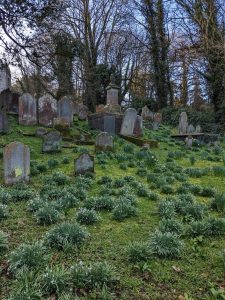 I was aware of another memorial in the churchyard which is known locally as the Atholl monument. Since Murray was the name of the local Dukes of Atholl I went scrambling around among the overgrown graves. It took some time because the place is beautiful; a tangle of greenery dotted with moss covered stones. This is no modern, neatly laid out graveyard, but a piece of history. Many of the graves are sadly difficult to read but one or two are clear enough to give an indication of the long history of Kirk Braddan.
I was aware of another memorial in the churchyard which is known locally as the Atholl monument. Since Murray was the name of the local Dukes of Atholl I went scrambling around among the overgrown graves. It took some time because the place is beautiful; a tangle of greenery dotted with moss covered stones. This is no modern, neatly laid out graveyard, but a piece of history. Many of the graves are sadly difficult to read but one or two are clear enough to give an indication of the long history of Kirk Braddan.
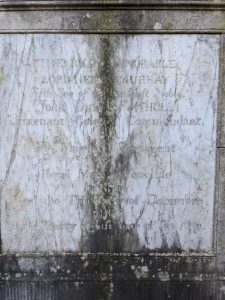 The Atholl monument turned out to be a large obelisk in the centre of the churchyard in honour of Lord Henry Murray, fourth son of John 3rd Duke of Atholl who was born in 1767 and died in the December of 1805. Lord Henry was the Lieutenant-Colone Commandant of His Majesty’s Regiment of Royal Manx Fencibles.
The Atholl monument turned out to be a large obelisk in the centre of the churchyard in honour of Lord Henry Murray, fourth son of John 3rd Duke of Atholl who was born in 1767 and died in the December of 1805. Lord Henry was the Lieutenant-Colone Commandant of His Majesty’s Regiment of Royal Manx Fencibles.
Henry Murray was appointed Colonel of the newly formed Royal Manx Fencibles in September 1795. In 1786 he married Eliza Kent and they had one son and five daughters. In 1796 the regiment was deployed to Derry because of unrest which led to the the Irish Rebellion of 1798 and in June of that year Murray ordered the burning of Ballymoney in reprisal for the rebellion. In February 1802 he went to Bath to recover from an attack of gout and later that year, following the Peace of Amiens, his regiment was disbanded. From 1804 Murray acted as Lieutenant-Governor and Deputy to his brother, John Murray, 4th Duke of Atholl, in his role as Governor of the Isle of Man.
Henry Murray died only a year later. His monument in Kirk Braddan Churchyard bears the inscription “This sincere testimonial of affection and deep regret for their commander and their friend is erected by the officers of the Regiment.” It was an age when tombs were expected to express sentimental feelings, but there is something rather touching about that very simple sentiment. Henry Murray was only thirty-eight when he died and may well have been a popular commander of the short-lived Fencibles, however unpopular he made himself in Ireland. Richard, his son, would have been seventeen when his father died and it is probable that an army career felt inevitable for him.
In researching this post I discovered that one of Henry Murray’s daughters made a marriage that really brought me close to my comfort zone in the Peninsular War of the early nineteenth century. In 1829 Amelia Jane Murray (usually known as Emily) married General Sir John Oswald. She was twenty-nine and he was a widower of fifty-eight who had previously been married to her cousin.
I’m very familiar with Oswald from the Peninsular War Saga. Oswald was born in Fife and educated in France, which meant he spoke good French and had close connections with the French aristocracy. Understandably he loathed the excesses of the French Revolution and wasn’t much keener on Bonaparte’s Empire. He served in the West Indies, the Netherlands, Malta, Italy, Egypt, the Adriatic and finally the Peninsular War under Wellington. He had a distinguished military career and his two marriages into the family of the Duke of Atholl clearly gave him a long connection to the Isle of Man.
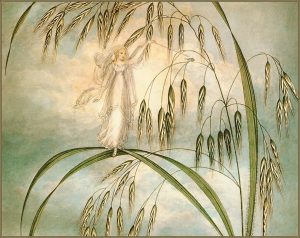 In book eight of the Peninsular War Saga which I’m currently writing, Oswald is about to have a difficult time at the siege of San Sebastian. I’m delighted I’ve found out about this now as it will give me a different sense of connection to the man. Incidentally, his second wife had a distinguished career of her own as a Victorian artist who specialised in fairies – a terribly Manx thing to do. I’d heard of her many times and seen her work but I had no idea she was married to one of Wellington’s generals. It’s like discovering that two old friends know each other.
In book eight of the Peninsular War Saga which I’m currently writing, Oswald is about to have a difficult time at the siege of San Sebastian. I’m delighted I’ve found out about this now as it will give me a different sense of connection to the man. Incidentally, his second wife had a distinguished career of her own as a Victorian artist who specialised in fairies – a terribly Manx thing to do. I’d heard of her many times and seen her work but I had no idea she was married to one of Wellington’s generals. It’s like discovering that two old friends know each other.
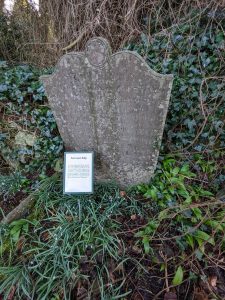 Back out in the churchyard, I wandered around admiring the snowdrops and making up stories in my head about some of the older graves. I wish more of them were legible. There are no neat paths laid out between the stones in this graveyard. It’s a little sad but also very beautiful compared to the neat rows of stones in a modern cemetery. As I was on a historic tour there was one more grave I wanted to see, also from my era but very different. Fortunately this one is well labelled now and the inscription very plainly copied.
Back out in the churchyard, I wandered around admiring the snowdrops and making up stories in my head about some of the older graves. I wish more of them were legible. There are no neat paths laid out between the stones in this graveyard. It’s a little sad but also very beautiful compared to the neat rows of stones in a modern cemetery. As I was on a historic tour there was one more grave I wanted to see, also from my era but very different. Fortunately this one is well labelled now and the inscription very plainly copied.
“An African slave of St Helena died the 28th of May 1822 aged 18 years. Born a slave and exposed in early life to the corrupt influence of that unhappy state, he became a model of truth and probity for the more fortunate of any country or condition. This stone erected by a grateful Master to the memory of a faithful servant who repaid the boon of Liberty with unbounded attachment.”
I know no more than that about Samuel Ally and his master and thus far I’ve not made an attempt to dig any further. Perhaps there is nothing more to find. I like the fact that this grave is marked and easy to find in Kirk Braddan Churchyard though. One one level it’s a rather lovely tribute from a master to a young servant. On another, it’s an important reminder of the significant involvement of the Isle of Man in the slave trade. There are probably a lot more such reminders scattered around the island. I’m fascinated by the topic and if I ever managed to drag myself to the other side of my two Napoleonic war sagas I’d like to find out more about it. There’s one book that I’ve found so far, which is informative but a bit dry and I know the museum has produced some material but I have a feeling there’s a lot more to be discovered.
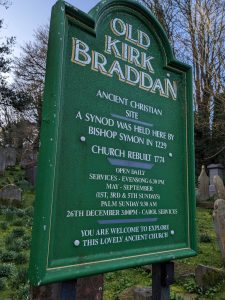 With time running out, I made my way back to the car, careful not to trip over a fallen gravestone in the tangle of grass and plants. I love ancient churches and graveyards and I’ve a feeling there are a few more I’ve not yet properly explored on the island so expect further posts. I especially love those which would have been here, an important part of island community life when my Manx sea captain and his wife first met in 1806 or returned to visit in 1811. Standing in these quiet places imagining those people gives me a very real sense of history.
With time running out, I made my way back to the car, careful not to trip over a fallen gravestone in the tangle of grass and plants. I love ancient churches and graveyards and I’ve a feeling there are a few more I’ve not yet properly explored on the island so expect further posts. I especially love those which would have been here, an important part of island community life when my Manx sea captain and his wife first met in 1806 or returned to visit in 1811. Standing in these quiet places imagining those people gives me a very real sense of history.

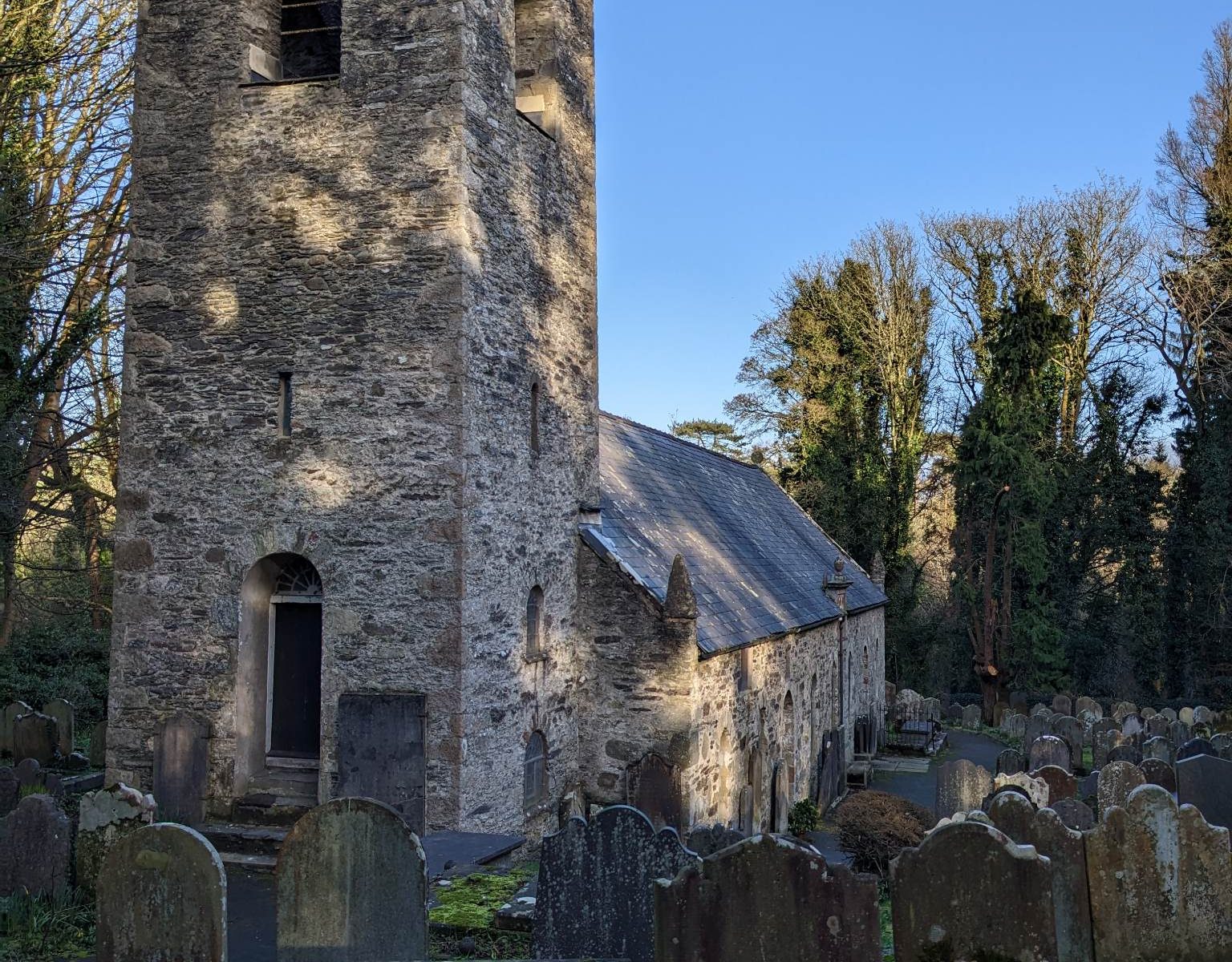
Fantastic post. The memorials are so poignant. It’s made me think more critically about how I view church memorials myself now when I’m visiting churches! Thank you for this very insightful post.
Thank you. I find them fascinating, especially when members of the same family are all buried in the same area. So many stories.